Suicide and mental health are intricately related. Mental health plays a significant role in suicidal thoughts and behaviors, highlighting the importance of awareness and support.
What Is Suicide?
Suicide is the act of intentionally taking one’s own life 1 Fazel, S., & Runeson, B. (2020). Suicide. The New England journal of medicine, 382(3), 266–274. https://doi.org/10.1056/NEJMra1902944 . It is a complex and tragic event that can have devastating consequences for individuals, families, and communities.
Suicidal behavior encompasses several actions, from suicidal ideation to suicide attempts and completed suicide. The warning signs of suicide can be noticed early on, including mood swings, social withdrawal, frequent confessions of hopelessness, death preoccupation, suicide planning and farewells, etc.
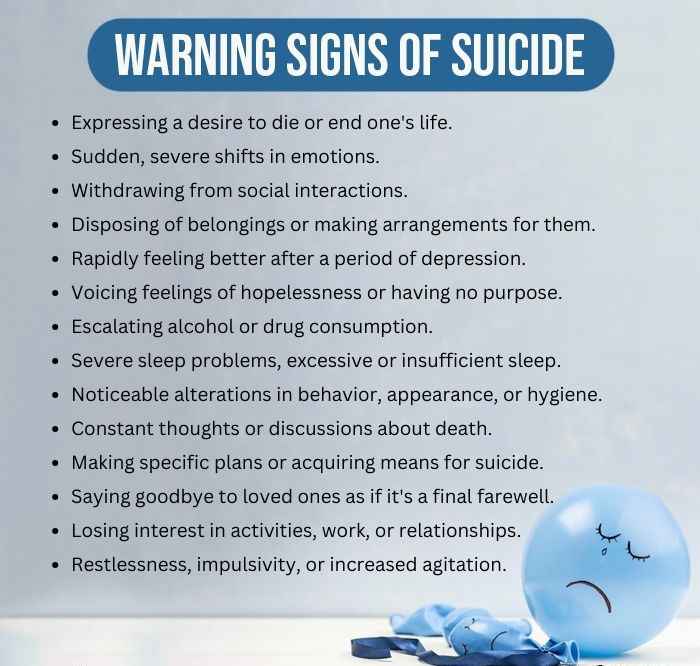
Understanding the nature of suicide involves exploring its causes 2 Soreff, S. M., Basit, H., & Attia, F. N. (2020). Suicide Risk. PubMed; StatPearls Publishing. Available from: https://www.ncbi.nlm.nih.gov/books/NBK441982/ and their association with emotional turmoil. Factors like life stressors, traumatic events, relationship problems, genetics, and mental health conditions contribute to the development of suicidal thoughts or attempts.
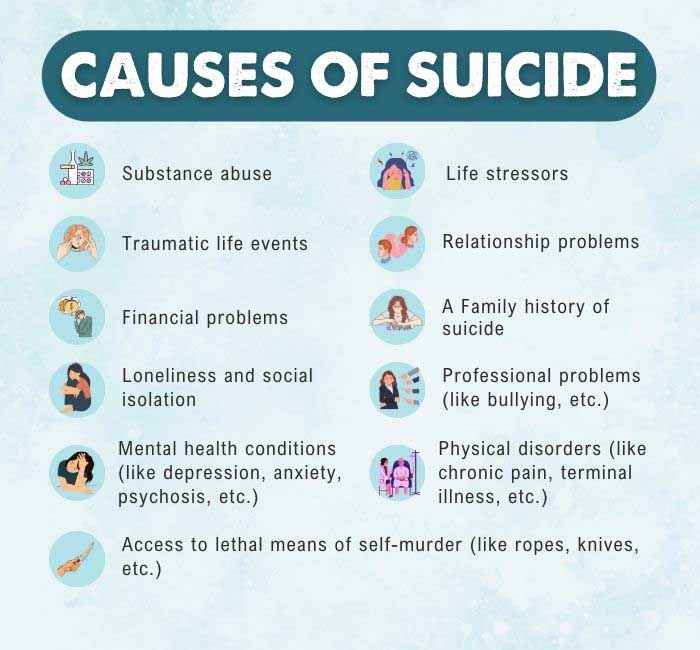
At the forefront, however, is the link between suicide and mental health. Research shows that untreated mental health conditions like depression, anxiety, trauma, mood disorders, and substance abuse issues makeup most of the 1 million suicide cases that occur annually across the world 3 Bachmann S. (2018). Epidemiology of Suicide and the Psychiatric Perspective. International journal of environmental research and public health, 15(7), 1425. https://doi.org/10.3390/ijerph15071425 . It is the top cause of death among individuals aged 15 to 44 years on a global scale. Historically, suicide rates have been higher among men than women.
Read More About Mood Disorders Here
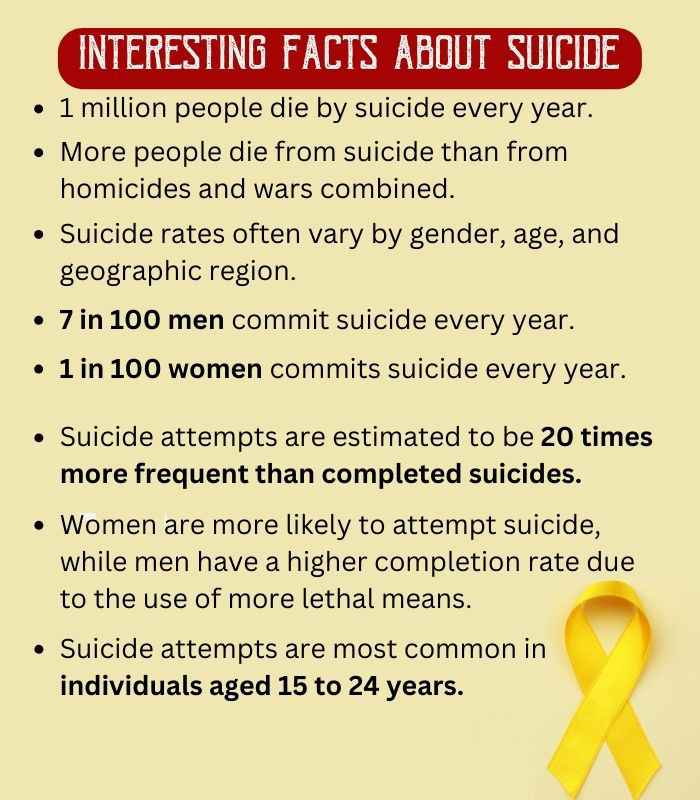
Suicide And Mental Health
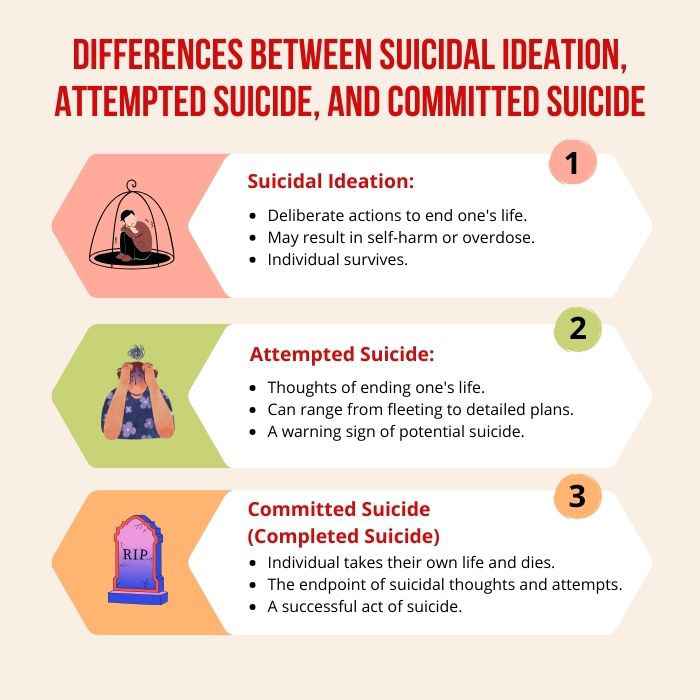
Suicide and mental health are intricately related 4 Brådvik L. (2018). Suicide Risk and Mental Disorders. International journal of environmental research and public health, 15(9), 2028. https://doi.org/10.3390/ijerph15092028 . Suicidal thoughts and attempts can hamper a person’s everyday functioning in several ways:
- Impaired Focus: Constant suicidal thoughts can hinder concentration and cognitive function.
- Emotional Turmoil: Suicidal ideation leads to emotional instability and difficulty managing feelings.
- Social Withdrawal: It often causes isolation and deepens loneliness.
- Sleep Disruption: Persistent suicidal thoughts disrupt sleep patterns.
- Neglected Self-Care: Basic self-care, like hygiene and nutrition, may decline.
- Low Self-Esteem: Negative self-image and self-criticism are common.
- Heightened Anxiety: Constant fear and uncertainty can lead to increased anxiety.
- Problem-Solving Challenges: Finding solutions to life’s problems becomes harder.
- Strained Relationships: Personal relationships may suffer due to communication difficulties.
- Self-Harm Risk: Suicidal thoughts can escalate to self-harming behaviors.
- Aggravated Mental Health Issues: Suicidal ideation often worsens coexisting mental health conditions like depression, schizophrenia, etc.
Read More About Self-Esteem Here
How Does Mental Illness Lead To Suicide Attempts?

Emerging studies 5 Sanati A. (2009). Does suicide always indicate a mental illness?. London journal of primary care, 2(2), 93–94. https://doi.org/10.1080/17571472.2009.11493259 have confirmed the link between the warning signs of suicide and mental health conditions, including:
- Depression: Prolonged feelings of sadness and hopelessness can lead to suicide attempts.
- Anxiety disorders: Severe anxiety and panic attacks may trigger thoughts of suicide as a way to escape distress.
- Bipolar disorder: Mood swings can include depressive episodes with suicidal thoughts and impulsive behavior during manic phases.
- Borderline personality disorder (BPD): Emotional instability and impulsivity in BPD can lead to self-harm and suicide attempts during crises.
- Post-traumatic stress disorder (PTSD): Traumatic experiences and distress can contribute to suicidal thoughts.
- Substance use disorders (SUD): Substance abuse impairs judgment and increases impulsive behavior, raising suicide risk.
- Schizophrenia: Symptoms like hallucinations can heighten the risk of suicide, especially during severe episodes.
- Eating disorders: Anorexia and bulimia-related distress may result in suicidal thoughts and self-destructive actions.
- Other personality disorders: Some personality disorders, like antisocial or narcissistic types, can lead to impulsive, risky behaviors increasing suicide risk.
Read More About Borderline Personality Disorder (BPD) Here
Suicide Across Life Stages And Domains
Depending on the changing realities between suicide and mental health conditions, suicide cases vary across age 6 Schmid, M., Michaud, L., Bovio, N., Guseva Canu, I., & Swiss National Cohort (SNC) (2020). Prevalence of somatic and psychiatric morbidity across occupations in Switzerland and its correlation with suicide mortality: results from the Swiss National Cohort (1990-2014). BMC psychiatry, 20(1), 324. https://doi.org/10.1186/s12888-020-02733-7 and occupational groups 7 Alexopoulos, E. C., Kavalidou, K., & Messolora, F. (2016). Suicide Mortality Across Broad Occupational Groups in Greece: A Descriptive Study. Safety and health at work, 7(1), 1–5. https://doi.org/10.1016/j.shaw.2015.09.004 :
1. Suicide In Children And Adolescents
Suicide is a leading cause of death in children and adolescents 8 Becker, M., & Correll, C. U. (2020). Suicidality in Childhood and Adolescence. Deutsches Arzteblatt international, 117(15), 261–267. https://doi.org/10.3238/arztebl.2020.0261 , often linked to factors like bullying, academic stress, family conflict, and mental health issues. Rates of suicide are especially high 9 Haas, A. P., Eliason, M., Mays, V. M., Mathy, R. M., Cochran, S. D., D’Augelli, A. R., Silverman, M. M., Fisher, P. W., Hughes, T., Rosario, M., Russell, S. T., Malley, E., Reed, J., Litts, D. A., Haller, E., Sell, R. L., Remafedi, G., Bradford, J., Beautrais, A. L., Brown, G. K., … Clayton, P. J. (2011). Suicide and suicide risk in lesbian, gay, bisexual, and transgender populations: review and recommendations. Journal of homosexuality, 58(1), 10–51. https://doi.org/10.1080/00918369.2011.534038 in teens belonging to the LGBTQIA+ community. Warning signs of suicide in them may include changes in behavior, social withdrawal, academic and parental conflict, and expressing a desire to die.
2. Suicide In Adults
Suicide in adults 10 Favril, L., Yu, R., Uyar, A., Sharpe, M., & Fazel, S. (2022). Risk factors for suicide in adults: systematic review and meta-analysis of psychological autopsy studies. Evidence-based mental health, 25(4), 148–155. https://doi.org/10.1136/ebmental-2022-300549 is influenced by factors, including workplace stress, relationship problems, financial difficulties, and mental health disorders. Warning signs of suicide in adults may encompass increased substance use, social isolation, and expressions of hopelessness. Further statistics reveal that suicide rates among adults working in the corporate sector and the healthcare industry remain a concerning public health issue.
3. Suicide In The Elderly
Elderly suicide 11 De Leo, D., & Giannotti, A. V. (2021). Suicide in late life: A viewpoint. Preventive medicine, 152(Pt 1), 106735. https://doi.org/10.1016/j.ypmed.2021.106735 is often linked to factors such as social isolation, declining health, loss of purpose after retirement, loss of previous social support, bereavement. Warning signs of suicide in the older population may include expressions of hopelessness, self-neglect, and giving away possessions.
Statistics indicate that suicide rates among the elderly are a rising concern, emphasizing the need for increased mental health support and community engagement to address this issue.
Treatment For Suicidal Ideation
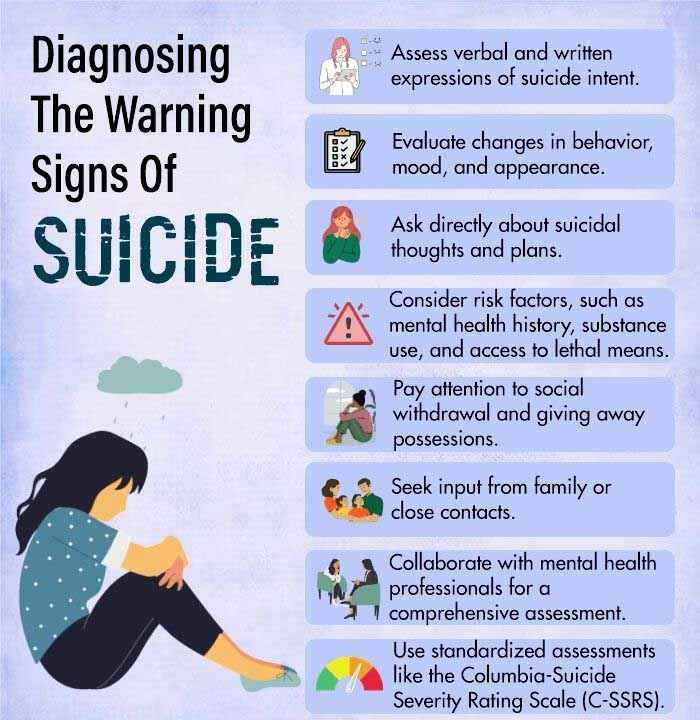
Treatment for suicidal ideation may include several therapies 12 Bruffaerts, R., Demyttenaere, K., Hwang, I., Chiu, W. T., Sampson, N., Kessler, R. C., Alonso, J., Borges, G., de Girolamo, G., de Graaf, R., Florescu, S., Gureje, O., Hu, C., Karam, E. G., Kawakami, N., Kostyuchenko, S., Kovess-Masfety, V., Lee, S., Levinson, D., Matschinger, H., … Nock, M. K. (2011). Treatment of suicidal people around the world. The British journal of psychiatry : the journal of mental science, 199(1), 64–70. https://doi.org/10.1192/bjp.bp.110.084129 including:
- Psychotherapy: Counseling with a trained therapist to explore and address the underlying causes of suicidal thoughts.
- Cognitive-behavioral therapy (CBT): A therapeutic approach that helps individuals identify and change negative thought patterns and behaviors related to suicide.
- Dialectical behavior therapy (DBT): Specialized for emotional regulation and interpersonal effectiveness, DBT is effective in managing suicidal thoughts and behaviors.
- Electro-convulsive Therapy (ECT): This therapeutic approach helps in treating severe cases of depression and suicidal ideation by inducing controlled seizures.
- Medication management: The use of prescribed medications, such as antidepressants or mood stabilizers, to alleviate underlying mental health conditions contributing to suicidal thoughts.
- Hospitalization or crisis intervention: In severe cases, individuals may require inpatient treatment for suicidal ideation, in order to gain safety and stabilization (followed by outpatient care).
Read More About Cognitive Behavioral Therapy (CBT) Here
Suicide And Mental Health Awareness
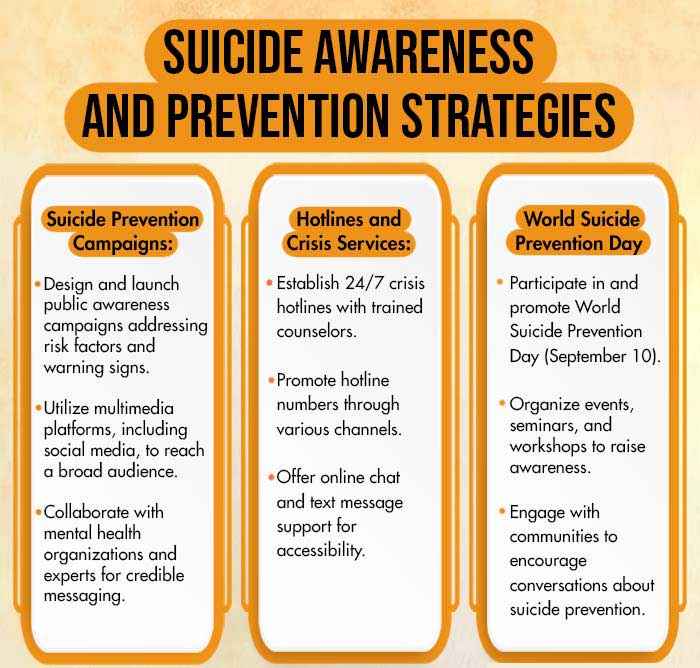
Suicide and mental health awareness are interconnected imperatives 13 Yeh, H. H., Westphal, J., Hu, Y., Peterson, E. L., Williams, L. K., Prabhakar, D., Frank, C., Autio, K., Elsiss, F., Simon, G. E., Beck, A., Lynch, F. L., Rossom, R. C., Lu, C. Y., Owen-Smith, A. A., Waitzfelder, B. E., & Ahmedani, B. K. (2019). Diagnosed Mental Health Conditions and Risk of Suicide Mortality. Psychiatric services (Washington, D.C.), 70(9), 750–757. https://doi.org/10.1176/appi.ps.201800346 for promoting emotional well-being and preventing suicide rates. Raising awareness about mental health challenges, reducing stigma, and fostering open conversations are vital steps in identifying and supporting individuals at risk of suicide.
These efforts, coupled with access to mental health services and support networks, play a critical role in reducing the prevalence of suicide and promoting overall mental wellness in communities.
Moreover, instances of suicides, especially celebrity suicides 14 Hedman-Robertson, A. S., & Sage, S. K. (2021). Celebrity Suicide. Crisis, 42(6), 418–424. https://doi.org/10.1027/0227-5910/a000734 , often amplify the link between suicide and mental health awareness. These tragic events serve as catalysts for public discussions, encouraging people to seek help and develop suicide prevention strategies.
Celebrities sharing their struggles with suicidal thoughts can inspire others to open-up about their own challenges—fostering a climate of empathy and driving home the importance of accessible mental health support.
How To Cope With Suicidal Thoughts
Consider the following measures 15 Mann, J. J., Michel, C. A., & Auerbach, R. P. (2021). Improving Suicide Prevention Through Evidence-Based Strategies: A Systematic Review. The American journal of psychiatry, 178(7), 611–624. https://doi.org/10.1176/appi.ajp.2020.20060864 on how to cope with suicidal thoughts and develop useful suicide prevention strategies:
- Reach Out: Share your feelings with a trusted friend or family member, or call a crisis helpline for immediate support.
- Safety Planning: Develop a safety plan that includes suicide prevention strategies and emergency hot-lines.
- Identify Triggers: Recognize situations or stressors that trigger suicidal thoughts and work on managing them.
- Self-Care: Prioritize self-help suicide prevention strategies like exercise, mindfulness, and relaxation techniques.
- Seek Professional Help: Consult with a mental health professional for treatment for suicidal ideation (like therapy or medication).
- Limit Access: Remove or restrict access to lethal means like firearms or medications.
- Positive Coping: Incorporate healthy coping mechanisms in suicide prevention strategies, such as journaling, art, or hobbies.
- Stay Connected: Maintain social connections and stay engaged with friends and family.
- Set Goals: Establish achievable goals to provide a sense of purpose and motivation.
- Educate Yourself: Learn about mental health, the warning signs of suicide, and measures on how to cope with suicidal thoughts.
Read More About Mindfulness Here
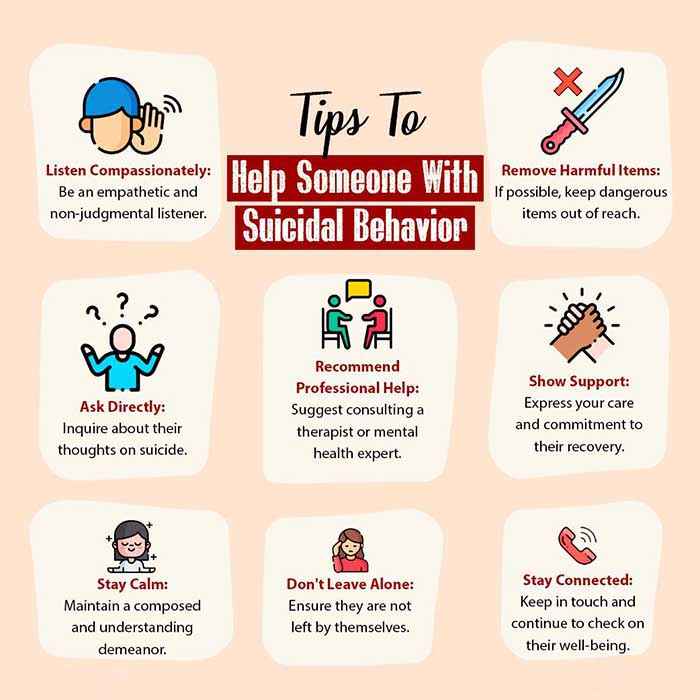
Coping With Suicide Grief
The aftermath of suicide leaves a profound impact on those left behind, often leading to complicated grief 16 Tal Young, I., Iglewicz, A., Glorioso, D., Lanouette, N., Seay, K., Ilapakurti, M., & Zisook, S. (2012). Suicide bereavement and complicated grief. Dialogues in clinical neuroscience, 14(2), 177–186. https://doi.org/10.31887/DCNS.2012.14.2/iyoung . Coping with suicide grief can be immensely challenging, requiring support from mental health professionals, support groups, or trusted friends and family members. Embracing open conversations about the loss, practicing self-care, and understanding that healing takes time are essential steps in navigating this emotional journey.
Takeaway
The intricate connection between suicide and mental health emphasizes the critical importance of raising awareness, reducing stigma, and providing accessible support. Suicide is a deeply personal tragedy, and by promoting mental health education and open conversations, we can strive for a world where well-being is prioritized, and hope replaces despair. Together, through suicide prevention efforts, we can extend a helping hand to those in need and save lives.
At A Glance
- Suicide is defined as the intentional act of taking one’s life.
- Mental illness, suicide, and mental health awareness are related.
- Warning signs of suicide include mood swings, social withdrawal, talk of hopelessness, etc.
- Mental health conditions, including depression, anxiety, and substance abuse often contribute to suicide attempts.
- Treatment for suicidal ideation includes psychotherapy, medication, hospitalization, and crisis intervention.
- Suicide prevention strategies encompass mental health education, stigma reduction, access to care, crisis hot-lines, support networks, etc.
- Measure on how to cope with suicidal thoughts comprise communicating effectively, embracing self-care, etc.
Frequently Asked Questions (FAQs)
1. What Are Suicidal Feelings?
Suicidal feelings are intense emotions of hopelessness, despair, and a desire to end one’s own life.
2. Why Do People Attempt Suicide When They Appear To Feel Better?
People might attempt suicide even when they seem to have improved because they could regain the energy and determination to carry out suicidal acts, while the underlying distress may still persist.
3. Does Suicide Always Indicate A Mental Illness?
Suicide doesn’t always indicate a mental illness; it can be driven by various factors, including social, environmental, or situational stressors.















